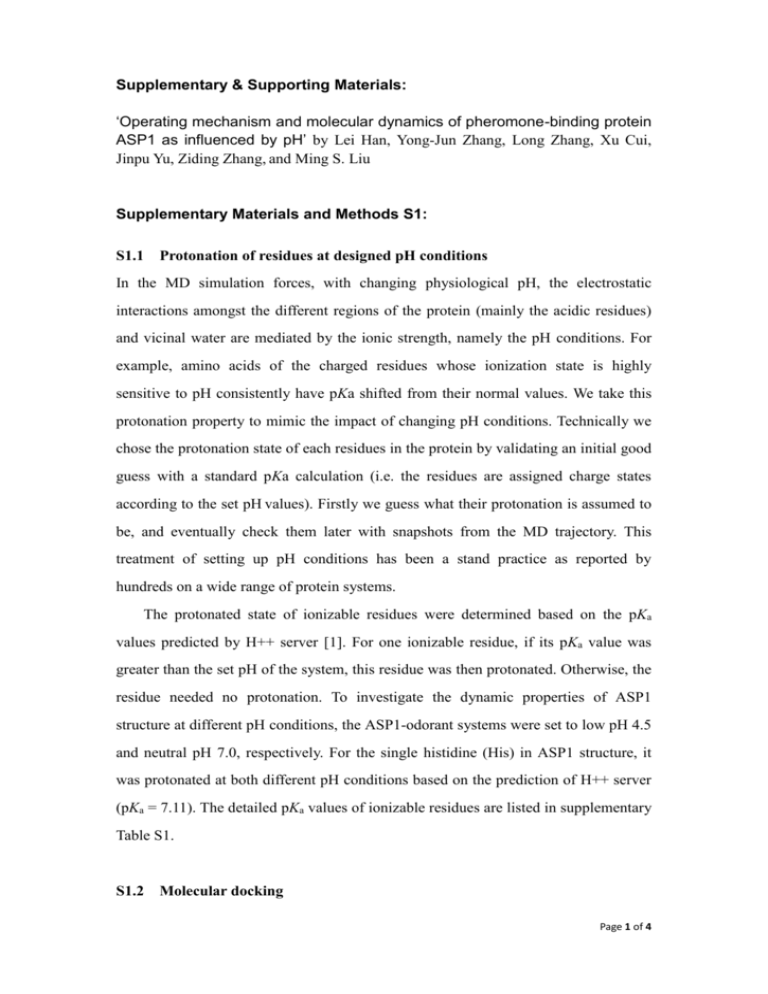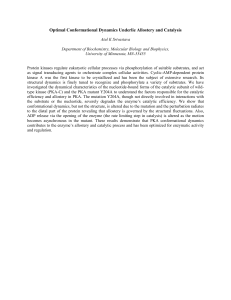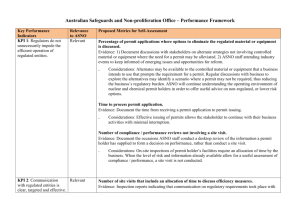Supplementary & Supporting Materials: `Operating mechanism and
advertisement

Supplementary & Supporting Materials:
‘Operating mechanism and molecular dynamics of pheromone-binding protein
ASP1 as influenced by pH’ by Lei Han, Yong-Jun Zhang, Long Zhang, Xu Cui,
Jinpu Yu, Ziding Zhang, and Ming S. Liu
Supplementary Materials and Methods S1:
S1.1
Protonation of residues at designed pH conditions
In the MD simulation forces, with changing physiological pH, the electrostatic
interactions amongst the different regions of the protein (mainly the acidic residues)
and vicinal water are mediated by the ionic strength, namely the pH conditions. For
example, amino acids of the charged residues whose ionization state is highly
sensitive to pH consistently have pKa shifted from their normal values. We take this
protonation property to mimic the impact of changing pH conditions. Technically we
chose the protonation state of each residues in the protein by validating an initial good
guess with a standard pKa calculation (i.e. the residues are assigned charge states
according to the set pH values). Firstly we guess what their protonation is assumed to
be, and eventually check them later with snapshots from the MD trajectory. This
treatment of setting up pH conditions has been a stand practice as reported by
hundreds on a wide range of protein systems.
The protonated state of ionizable residues were determined based on the pKa
values predicted by H++ server [1]. For one ionizable residue, if its pKa value was
greater than the set pH of the system, this residue was then protonated. Otherwise, the
residue needed no protonation. To investigate the dynamic properties of ASP1
structure at different pH conditions, the ASP1-odorant systems were set to low pH 4.5
and neutral pH 7.0, respectively. For the single histidine (His) in ASP1 structure, it
was protonated at both different pH conditions based on the prediction of H++ server
(pKa = 7.11). The detailed pKa values of ionizable residues are listed in supplementary
Table S1.
S1.2
Molecular docking
Page 1 of 4
To create a ligand-bound state of ASP1, AutoDock 4.2 program [2] was used to dock
palmitic acid into apo ASP1 structure. AutoDock Tools version 1.5.6 was used to
prepare the materials for molecular docking and to analyze the docking results. The
grid maps with a spacing of 0.375 Å were generated by AutoGrid. 50 runs were
produced using Lamarckian Genetic Algorithm (LGA) algorithm [3], with 2.5 x 107
energy evolution per run. All other parameters were set to default AutoDock values.
The lowest energy conformation of complex, in which ligand had the similar
conformation as the ligand in holo ASP1 structure, was selected as the initial structure
for molecular dynamics simulation.
S1.3
Molecular dynamics simulations
We performed all atom molecular dynamics (MD) simulation on the apo and holo
states of ASP1 at different pH conditions to examine how pH affect the dynamics and
ASP1-ligand interactions. In order to capture the odorant releasing mechanism as per
influenced by pH, our simulations were focused on the holo states with varying pH
conditions. All molecular dynamics simulation systems were prepared and visualized
with VMD [4]. The TIP3P model waters were used to solve the ASP or ASP-ligand
complexes in a periodic boundary cubic box extending up to 10 Å from the protein to
boundary in each direction [5]. Sodium and chloride ions, with concentration of 0.1M,
were added to neutralize the net charge of the OBP and water systems.
MD simulations were performed on NAMD (version 2.8) [6] with the
CHARMM27 force field [7,8]. Firstly, the systems were energy minimized for 5000
steps and then 100 ps of simulation was performed with solute restrained. Three
similar processes were carried out with restraining heavy atoms of protein, ligand and
backbone of protein respectively. After that, the temperature of systems were
gradually heated to 300K during 30ps Langevin dynamics using a time step of 1fs
following 5ns system NVT equilibration without any restraint. For each system,
200ns MD production runs were performed at NPT ensemble keeping the temperature
at 300k and the conformations were conserved every 0.1ps for subsequent analysis.
Page 2 of 4
For MD production running, the temperature and pressure of systems were controlled
using Langevin dynamics with a damping coefficient of 1 ps-1 and Nose’-Hoover
methods, respectively. Van der Waals force was truncated at 12 Å and particle
Mesh-Ewald (PME) summation scheme was used to handle the long range
electrostatic interaction [9]. For explore more comprehensive conformational space of
ASP1 at different pH conditions, three replicates of MD were produced for each pH
condition (pH4.5 and pH7.0)
and subsequent dynamics analysis (such as RMSD,
RMSF, distance between residues or component of ASP1) were conducted by
averaging the triplicates.
S1.4
Free energy perturbation calculation
The relative binding energy for the ASP1-ligand complexes was calculated using free
energy perturbation
(FEP)
method
[10],
where
in
FEP
calculation
the
thermodynamics cycle was followed as in Fig. S3.a. In our FEP calculation process,
dual topology approach was used [11], with the initial state set at (λ = 0, pH4.5
condition and the final state set at (λ = 1, pH7.0) respectively. In MD simulations with
the system transiting from the initial state to the final state, the relative binding energy
difference was calculated as [11],
G 0 1
Here β=
1
1
ln
0
exp( ( H ( ) H ( ) ))
(s1)
1
, kB is the Boltzmann constant, T is the temperature and H is the total
k BT
energy of system. λ = 0 and λ = 1 represented the holo-ASP1 in pH4.5 and pH7.0
states, respectively. In our FEP process, the standard stepping δλ was set as 0.05.
However, at the start and close to the final states, the interval sequence of λ, i.e. δλ,
was set as {0, 0.00001, 0.0001, 0.001, 0.01, 0.03, 0.05, 0.08, 0.1} and {0.9, 0.92 ,0.95,
0.97, 0.99, 0.999, 0.9999, 0.99999, 1}, which in total we had 32 intermediate λ states
(i.e. total of 16 intermediate λ states around the start and final states and other 16
intermediate states were assigned to process λ from 0.1 to 0.9).
At each λ state,
Page 3 of 4
200ps simulation was run to equilibrate the ASP1-ligand system and then 500ps
simulation was produced to collect the energetics data. Other parameters for FEP
calculation were set the same as the standard MD simulation.
Supplementary references:
1. Gordon JC, Myers JB, Folta T, Shoja V, Heath LS, et al. (2005) H++: a server for
estimating pKas and adding missing hydrogens to macromolecules. Nucleic Acids Res
33: W368-W371.
2. Morris GM, Huey R, Lindstrom W, Sanner MF, Belew RK, et al. (2009) AutoDock4 and
AutoDockTools4: Automated docking with selective receptor flexibility. J Comput
Chem 30: 2785-2791.
3. Morris GM, Goodsell DS, Halliday RS, Huey R, Hart WE, et al. (1998) Automated
docking using a Lamarckian genetic algorithm and an empirical binding free energy
function. J Comput Chem 19: 1639-1662.
4. Humphrey W, Dalke A, Schulten K (1996) VMD: Visual molecular dynamics. J Mol Graph
14: 33-38.
5. Jorgensen WL, Chandrasekhar J, Madura JD, Impey RW, Klein ML (1983) Comparison of
simple potential functions for simulating liquid water. J Chem Phys 79: 926-935.
6. Phillips JC, Braun R, Wang W, Gumbart J, Tajkhorshid E, et al. (2005) Scalable molecular
dynamics with NAMD. J Comput Chem 26: 1781-1802.
7. MacKerell AD, Bashford D, Bellott, Dunbrack RL, Evanseck JD, et al. (1998) All-Atom
Empirical Potential for Molecular Modeling and Dynamics Studies of Proteins†. J Phys
Chem B 102: 3586-3616.
8. MacKerell AD, Banavali N, Foloppe N (2000) Development and current status of the
CHARMM force field for nucleic acids. Biopolymers 56: 257-265.
9. Darden T, York D, Pedersen L (1993) Particle mesh Ewald: An Nlog(N) method for Ewald
sums in large systems. J Chem Phys 98: 10089-10092.
10. Kollman P (1993) Free energy calculations: Applications to chemical and biochemical
phenomena. Chemical Reviews 93: 2395-2417.
11. Pearlman DA (1994) A Comparison of Alternative Approaches to Free Energy
Calculations. The Journal of Physical Chemistry 98: 1487-1493.
Page 4 of 4







